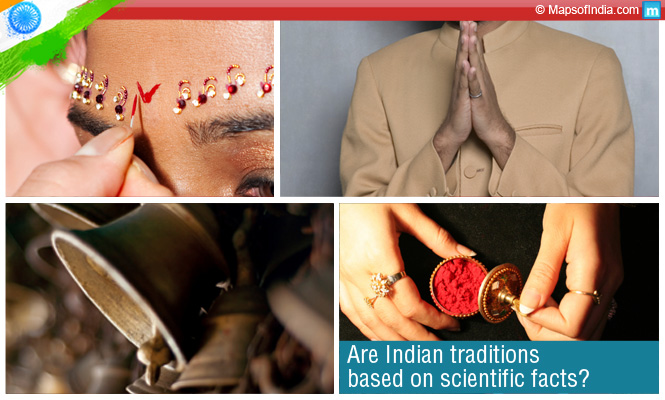There are various traditions and beliefs that have been followed by Hindu Indians since ancient times. Most of these beliefs, it is argued nowadays, are superstitions which people follow blindly for the fear of being cursed or harmed by supernatural powers or God. However, research studies have shown now that some of these beliefs or superstitions have scientific reasons associated with them. Sounds strange, isn’ it? Let us check out some of these with their scientific explanations:
Why do we throw coins into wells and rivers?
Usually, the belief is that it brings luck. Nowadays, coins are made of stainless steel. In ancient times, most of the coins were made of copper and intake of copper was helpful for the human body. Copper and silver have anti-bacterial properties. Our forefathers threw copper coins in the water, so that when they take bath using that water, they can have sufficient intake of copper. It was made a custom so that we follow it.
Why do we greet people with a “Namaskar”?
It is an age old Hindu culture when people greet each other with a “Namaskar” or joining both the palms of their hands. The Namaskar tradition is associated with paying respect to the other person. But, scientifically explained, it means that when the palms are joined, the tips of all the fingers also join, which are in fact the pressure points of eyes, ears and mind. Pressing them means you can remember that person for a long time as it activates the pressure points.
Why do women wear silver toe rings?
There is science behind wearing a silver toe ring by a married Indian woman. It is worn on the second toe. A nerve from the second toe connects the uterus and then to the heart. Wearing silver toe ring strengthens and keeps the uterus healthy by regulating the menstrual cycle.
Why do we apply red tilak on our foreheads?
As a custom, women put on a bindi to display that they are married and men put on a tilak on religious occasions. However, scientifically, it is said that the spot between the two eyebrows is a major nerve point in human body. The ancient concept is to prevent loss of “energy”; the red ‘kumkum’ retains energy and controls the various levels of concentration.
Why do married Indian women apply sindoor or vermillion?
Though sindoor, since ancient times is associated with married women, studies have shown that it has scientific reason behind it. It is to be noted that sindoor is a mixture of turmeric, lime and the metal mercury, which have their intrinsic properties. Mercury helps in controlling blood pressure, removing stress and strain and it also stimulates sexual drive. That is why sindoor is prohibited for the widows.
Why do we ring bells in the temples?
As soon as we enter the temple, before entering the main shrine, we always ring the metal bells hanging at the entrance. As a tradition, we believe that the sound of the bell keeps evil forces away and it is pleasant to God. However, the scientific reason is that when we ring the bell, it clears our mind, help us to focus and stay sharp on our devotion to God. These sounds produced by the bells create a harmony between the left and right sides of our brain and the sounds last for minimum of 7 seconds in echo mode. This echo sound activates all the seven healing centres in our body and helps our mind to get rid of all negative thoughts.
Why do we worship the peepal tree?
Logically seen, except the shade, peepal tree is usually a useless tree as it does not bear any fruit nor is the wood strong for any purpose. Even then, since ancient times, we have shown deep reverence for this tree and we worship it. Why? According to scientific research this is the only tree that produces oxygen even at night. Our forefathers knew about it. So in order to save the tree from being cut, they related it to God or religion.
Why can’t we sleep with our head towards north?
The superstition is that it invites ghost or death. But, according to science, human body has its own magnetic field and earth is also a giant magnet. It is said that if we sleep with our head in the north direction, our body’s magnetic field becomes completely asymmetrical to the magnetic field of the earth, which can cause health problems and the heart needs to work harder to get rid of this asymmetry of magnetic fields.
Why do we keep fasts on Navratris?
Have you ever thought why we have Navratris twice a year and why do we keep fasts? No doubt, we keep fasts on Navratris, as it has been associated with invoking the blessings of Maa Shakti. Scientific reason for this is that both the months of Navratris are the months of changing seasons. The nine days of fast give our body enough time to adjust to the changing season and also help in detoxifying the body.
Why do we touch feet of others?
Usually we touch the feet of our elders or the pious ones. To bow down and touch someone’s feet means our ego is reduced and when the other person accepts our respect, it means that his heart emits positive thoughts and energy, which reaches us through his hands and toes. The entire completed circuit helps in the flow of energy, creating a quick connect between two minds and hearts. The same explanation can be given for hugs.




